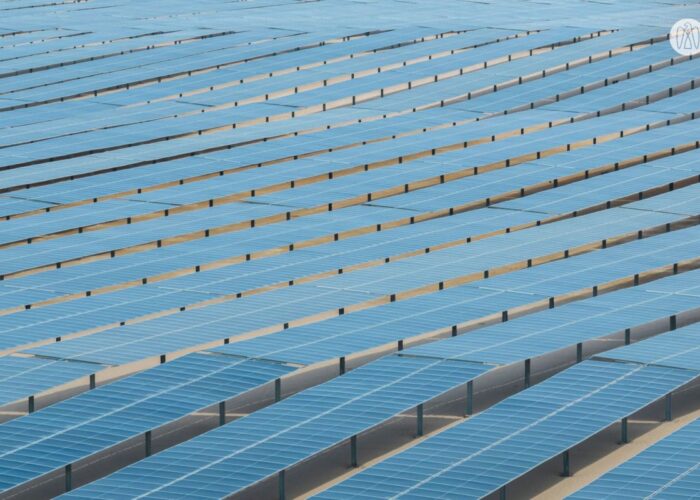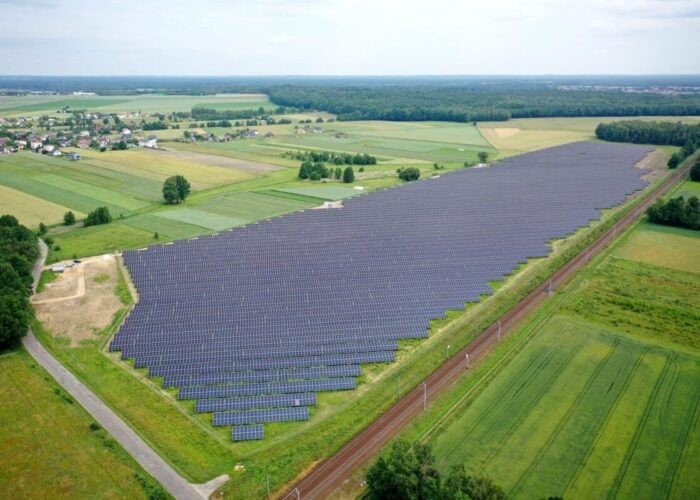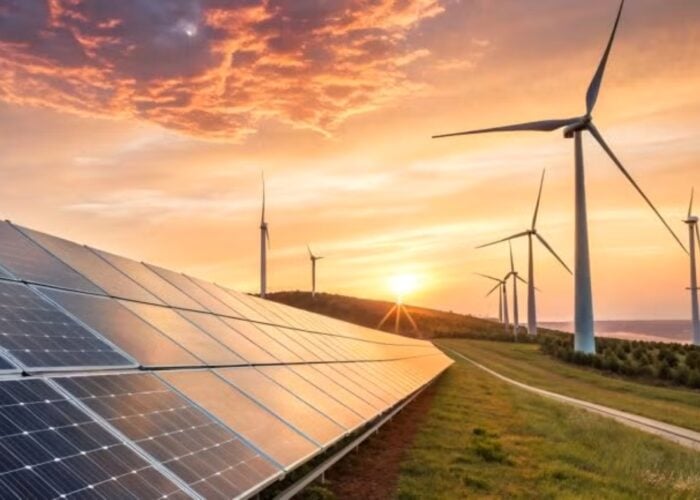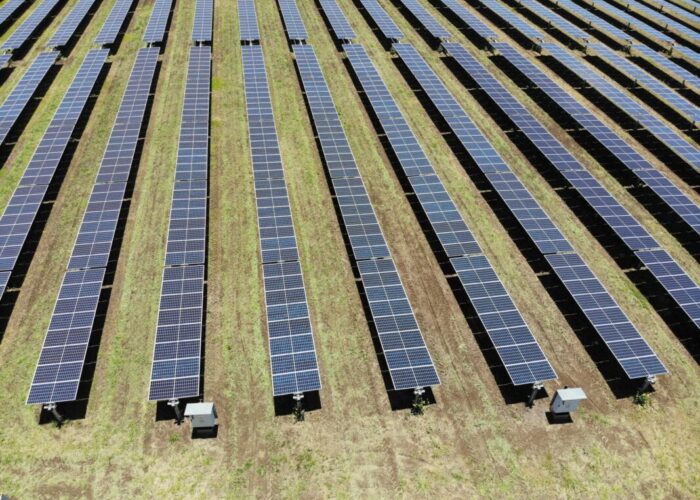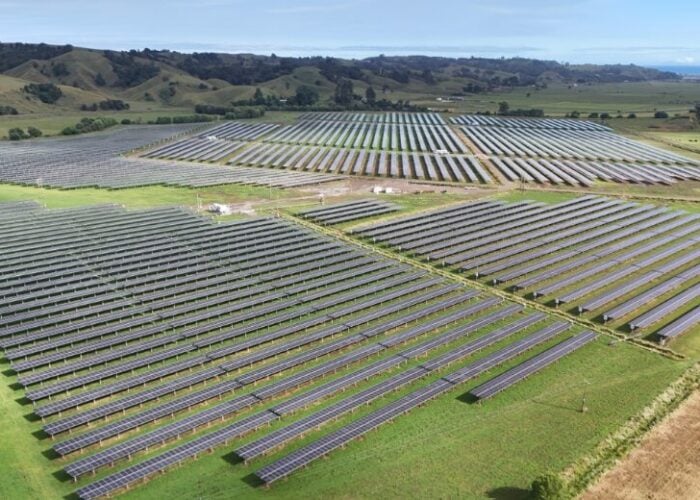
Part one of PV Tech’s series of articles recapping 2019, covering the first three months of the year, can be found here.
Part two of PV Tech’s series of articles recapping 2019, covering April – June, can be found here.
Try Premium for just $1
- Full premium access for the first month at only $1
- Converts to an annual rate after 30 days unless cancelled
- Cancel anytime during the trial period
Premium Benefits
- Expert industry analysis and interviews
- Digital access to PV Tech Power journal
- Exclusive event discounts
Or get the full Premium subscription right away
Or continue reading this article for free
Bifacial dodges upstream fallout from trade war
Much like all other industries this year, upstream solar was dragged in Q3 2019 into the high-stakes trade war pitting the US against rival superpowers worldwide.
For PV makers, the risks of operating in a world carved by protectionist rifts were again laid bare in July and August, as Donald Trump’s US and Xi Jinping’s China clashed over solar policies before the World Trade Organisation. Beijing seemed to have the upper hand as rulings recognised its right to seek retaliation for US import duties and investigate the legality of US subsidies. A similar WTO push by Narendra Modi’s India had delivered, in June, another defeat by Washington DC.
Most high-profile of all was of course the row over Section 201 duties imposed by the Trump administration. June marked the launch of a popcorn-worthy saga, when the US moved to spare bifacial from import tariffs (acting later to reverse the exemption in a u-turn the courts have temporarily blocked). Analysts surveying the policy swings were adamant bifacial will prosper whatever the end of the still-ongoing court case. By 2024, some said, global capacity will hit 21GW.
Being targeted by the protectionist instincts of one of the world’s largest solar markets did not seem to faze Chinese PV makers, with many guiding sales hikes in July. Canadian Solar cited strong demand as it boosted module capacity past 12GW in August, trumpeting a cell efficiency breakthrough a month later. From LONGI’s Hi-Mo X launch to Jinko Solar’s rapidly-filling up order book, the headlines coming from other household names were equally bullish.
The mood music was more muted among Chinese inverter players, with Sungrow, Ginlong and Kehua all guiding weaker profits in July. The picture produced by the segment beyond Chinese borders was mixed, from SolarEdge’s repeated quarter sales records to ABB’s plummeting income after paying – yes, paying – US$470 million for a buyer to snap up its solar inverter business. Approached by PV Tech, the firm cited falling global demand for inverters as a key culprit.
An intriguing Q3 2019 side development was the rise of an unlikely campaign to revive European PV manufacturing, led by hyperactive French president Emmanuel Macron. The 41-year-old’s plan to use a mixture of policy and research to bring back European “champions” – decimated by low-cost Asian rivals and the phase-out of EU MIP tariffs – was either Europe’s second chance or a quest doomed to fail, depending on who PV Tech asked.
Tesla feels heat of rooftop fire lawsuit as US solar enters campaign mode
With talk of next year’s possible re-election of US president Trump intensifying in 2019, US solar saw itself swept along into the political arena.
From frontrunner Joe Biden to fellow contenders Elizabeth Warren and Bernie Sanders, Democratic presidential hopefuls flexed their solar credentials at a New York debate in September. Trump-supporting Republicans sided at several points with Democrat counterparts – see the bipartisan push against renewables red-tape – but the federal government was ready to clash against solar interests, tabling a watering-down of mandatory renewable purchases that triggered PV’s concern.
Much of US solar’s pre-election campaigning coalesced around a particular three-letter acronym. Calls to scrap the current timetable to phase out solar investment tax credits (ITC) were led by US PV body the SEIA – which argued an ITC extension would boost PV output by a third by 2030 – but also taken up by nearly 1,000 solar firms. Most importantly, they were heard at Washington DC, with a bipartisan bill proposing in July a five-year full-rate ITC extension.
In solar’s Q3 2019, rising policymaker support combined with the enthusiasm of US corporates. In July, SEIA stats showed procurement moves by the likes of Apple and Amazon had boomed US-wide between 2017 (7,000 projects, 2.GW) and 2018 (35,000, 7GW). The quarter produced a high-profile case in point, with Google citing cost drops as it announced in September a move towards solar buys, with major offtake PV deals spanning the US, Chile and even cloudy Denmark.
The quarter was not quite so buoyant for Tesla. To the usual Twitter spats of its CEO, Elon Musk’s outfit added in Q3 2019 being on the receiving end of a lawsuit by US retail colossus Walmart, which linked a string of store fires to Tesla’s alleged mismanagement of solar panel installation and maintenance; similar reported claims by Amazon days later stoked the controversy. This particular saga ended well for Tesla however, with Walmart dropping the lawsuit in later quarters as PV installs rebounded.
The Portuguese-speaking face of the low-cost solar revolution
The year’s third quarter was, like all others in 2019, littered with declarations of exactly how golden the current era is for solar. The UN itself branded PV the “star” of a decade of renewable growth, while Wood Mackenzie consultants predicted record-high roll-out levels of 114.5GW this year. Both sides linked their optimism to the same trend, a mantra so oft-repeated today it is becoming an assumed fact: the dizzying dive of solar technology costs.
While PV cost-competitiveness is reaching the world’s four corners, two countries were able to capture the limelight like no other in Q3 2019. Brazil’s average solar tariffs of BRL67.48/MWh (around US$17.5/MWh) at a renewable auction in late June were pronounced a “global milestone”; proof that fossil fuels no longer get to play the competitiveness card. The PV oversubscription of the A-4 tender – 203MW contracted where 26.2GW in bids was tabled – was head-turning.
The auction records did little to dispel the hype already surrounding Brazil, where PV is enjoying a moment in the sun with the support of unlikely champion president Jair Bolsonaro. As explored by a recent PV Tech Power feature, the former army captain – for the most part a staunch anti-environmentalist – has thrown his weight behind solar, opening up formerly off-limits auction schemes and sponsoring major industry-friendly investment projects.
As eye-catching as Brazil’s US$17.5/MWh was, its claim to auction record fame was to be short-lived. Around one month later, Portugal raced ahead as its solar-only auction – also the subject of a bidding avalanche – produced PV prices as low as €14.76/MWh (US$16.44, based on current exchange rates). Breaking the news to PV Tech, Energy state secretary João Galamba sounded buoyant about Portugal’s odds of success with its plans to near 10GW of PV capacity by 2030.
The triumphant headlines around Brazil and Portugal were shadowed by uneasy murmurs from certain quarters, with analysts questioning how the auction winners committing to record-low PPA support would make money in the long run. As BloombergNEF’s Jenny Chase noted right after Brazil’s tender results came out, the fact that staff driving auction wins at developers today may have left when construction begins creates an incentive to “roll the dice” now on big technology cost reductions.
Financially sounder solar-plus-storage reaches coming-of-age moment
The stories filling up PV Tech’s Q3 2019 newsletters illustrated again a premise that has become undeniable: you can’t discuss solar without discussing storage. Our dedicated PV Tech Power issue explored the current strengths and shortcomings of the still-maturing battery segment and others, at the time when the EIB, Australia’s CEFC, BlackRock and others are zeroing in on them as the technologies that will make or break the green transition.
The year’s third quarter produced a deluge of solar-plus-storage moves, led by an absolute headline-grabber in Australia. In July, Northern Territory first minister Michael Gunner confirmed his government had granted major project status to a scheme that bewildered the PV Tech ranks not only because of its sheer planned size – 10GW of solar, 20-30GWh of storage – but its mission: to power, via a 3,800 km submarine cable, a fifth of Singapore’s electricity needs.
Further Q3 2019 solar-plus-storage forays concentrated around Australia – see Ib vogt’s 109MW/100MWh hybrid or RES’s 200MW/10MW solar – but also the US, with BlackRock, Capital Dynamics, EDP, Engie and major states all making moves over the quarter. Beyond the English speaking world, Chile stole some of the spotlight in July, when it emerged that developer Valhalla was lining up UN money for a 561MW/300MW PV-plus-pumped-storage hybrid in Atacama.
Despite Europe’s absence from the Q3 2019 solar-plus-storage bonanza, the continent was told by analysts over the quarter its hybrids are already economically feasible. Studies by ETIP PV and Wood Mackenzie offered different renditions of the same tune: the fact that grid parity, particularly in Germany and Southern Europe, is or will soon be a reality. As if to confirm the US would not fall behind, 8minute’s 400MW/1,200MWh Los Angeles hybrid scored US$0.013-0.01997/kWh PPA prices in September.
Solar’s hybrid appetites increasingly took it to alliances with wind. From Germany’s policy squabbles to the US’ ITC wars, both sources may often be presented as if in conflict but the renewable space appears ready to mix them. In Q3 2019, PV Tech counted milestones in at least Australia (Neoen’s Crystal Brook, Genex’s Kidston), the US (NextEra’s Skeleton Creek), Europe (Vattenfall’s Haringvliet), Kenya (Eurus’s and Windlab’s Meru County) and Zambia (Upepo Energy Partner’s hybrid).
Spain leads, others follow as Europe presses on with subsidy-free voyage
If 2019 was overall the year when subsidy-free solar reached unprecedented heights, the third quarter was responsible for some of the key highlights.
Spain was in Q3 2019, as it was in the quarters before and after it, the driving force of much of it all. The country’s mix of solid resource, available land and for-now high power prices is luring in developers in their droves and the subsidy-free plays are getting more daring. Where most are still sheltering under the safety of a PPA – see the 10-year deal inked in September for 300MWp Talayuela – some, like Renovalia’s 79.2MW scheme, are enlisting top banks as they go full merchant.
BayWa r.e. added a new spin to the subsidy-free story this year as it went bank-free, shorter-PPA for the 50MWp sequel to its 175MWp Don Rodrigo debut, a series some see as iconic of Spain’s zero-subsidy potential. Speaking to PV Tech in early September, the developer shed light on why investors are ready to go full equity despite the squeezed PPA. Too long a timeframe, said the firm, and all parties involved – developer, financier, offtaker – would be locked for years of potential power price swings.
While perhaps more muted, the ripples of the subsidy-free wave extended northwards in Europe in Q3 2019. In late September, investor Bluefield Solar Income Fund signalled its faith in the approach in the UK as it revealed it had signed a “select number of agreements” for projects planned without a penny of public support. Germany – which scrapped PV subsidy limits the same month – too saw a major subsidy-free endorsement after investors CEE and THEE announced a 500MW pipeline.
The year’s third quarter also brought a brighter turn of events for Europe’s slumbering PV giant. Italy – still the EU’s second top market even after subsidy u-turns froze deployment – restarted government incentives in Q3 2019 but the industry, as PV Tech heard at an event weeks later, does not want subsidies, but rather a market redesign that limits bureaucracy. Reinforcing the premise, utilities and developers would go on to line up major subsidy-free moves in Italy in Q4 2019.
Solar's new era in Europe and beyond will take centre stage at Solar Media's Solar Finance & Investment Europe (London, 5-6 February) and Large Scale Solar Europe 2020 (Lisbon, on 31 March-1 April 2020).
The prospects and challenges of Latin American solar and storage will be explored at Solar Media's Energy Storage Latin America, to be held in Colombia on 28-29 April 2020.

